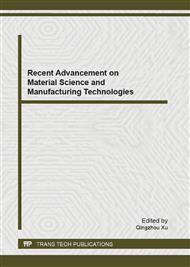[1]
Bersuker G., Gilmer D. C., Veksler D., et al., Metal oxide resistive memory switching mechanism based on conductive filament properties, JOURNAL OF APPLIED PHYSICS, 2011, 110(12): 124518.
DOI: 10.1063/1.3671565
Google Scholar
[2]
C. Rohde, B.J. Choi, D.S. Jeong et al. Identification of a determining parameter for resistive switching of TiO2 thin films [J]. Appl. Phys. Lett., 2005, 86(26):262907.
DOI: 10.1063/1.1968416
Google Scholar
[3]
C.B. Lee, B.S. Kang, A. Benayad et al. Effects of metal electrodes on the resistive memory switching property of NiO thin films [J]. Appl. Phys. Lett., 2008, 93(4):042115.
DOI: 10.1063/1.2967194
Google Scholar
[4]
S. Zhang, S. B. Long, W. H. Guan, Q. Liu, Q. Wang, M. Liu. Resistive switching characteristics of MnOx-based ReRAM [J]. Journal of Physics D-Applied Physics, 2009, 42(5): 055112.
DOI: 10.1088/0022-3727/42/5/055112
Google Scholar
[5]
Ahn Youngbae, Lee Jong Ho, Kim Gun Hwan, Concurrent presence of unipolar and bipolar resistive switching phenomena in pnictogen oxide Sb2O5 films, JOURNAL OF APPLIED PHYSICS, 2012, 112(11):114105
DOI: 10.1063/1.4767918
Google Scholar
[6]
D. Lee, D. J. Seong, I. Jo, F. Xiang, R. Dong, S. Oh, H. Hwang. Resistance switching of copper doped MoOx films for nonvolatile memory applications [J]. Applied Physics Letters, 2007, 90(12): 122104.
DOI: 10.1063/1.2715002
Google Scholar
[7]
K. Nagashima, T. Yanagida, K. Oka, T. Kawai. Unipolar resistive switching characteristics of room temperature grown SnO2 thin films [J]. Applied Physics Letters, 2009, 94(24): 242902.
DOI: 10.1063/1.3156863
Google Scholar
[8]
X. Sun, H. Kwok. Optical properties of epitaxially grown zinc oxide films on sapphire by pulsed laser deposition [J]. J. Appl. Phys., 1999, 86(1):408-411.
DOI: 10.1063/1.370744
Google Scholar
[9]
X. H. Yu, J. Ma, F. Ji, Y. H. Wang, C. F. Cheng, H. L. Ma. Thickness dependence of properties of ZnO : Ga films deposited by rf magnetron sputtering [J]. Applied Surface Science, 2005, 245(1-4): 310-315.
DOI: 10.1016/j.apsusc.2004.10.022
Google Scholar
[10]
C.B. Lee, B.S. Kang, A. Benayad et al. Effects of metal electrodes on the resistive memory switching property of NiO thin films [J]. Appl. Phys. Lett., 2008, 93(4):042115.
DOI: 10.1063/1.2967194
Google Scholar
[11]
S. Spiga, A. Lamperti, C. Wiemer et al. Resistance switching in amorphous and crystalline binary oxides grown by electron beam evaporation and atomic layer deposition [J]. Microelectronic Engineering, 2008, 85(12):2414-2419.
DOI: 10.1016/j.mee.2008.09.018
Google Scholar
[12]
Youn Hee Kang, Ji-Hyuk Choi, Tae Il Lee,Woong Lee, Jae-Min Myoung. Thickness dependence of the resistive switching behavior of nonvolatile memory device structures based on undoped ZnO films [J]. Solid State Communications, 2011, 151:1739–1742.
DOI: 10.1016/j.ssc.2011.08.036
Google Scholar


